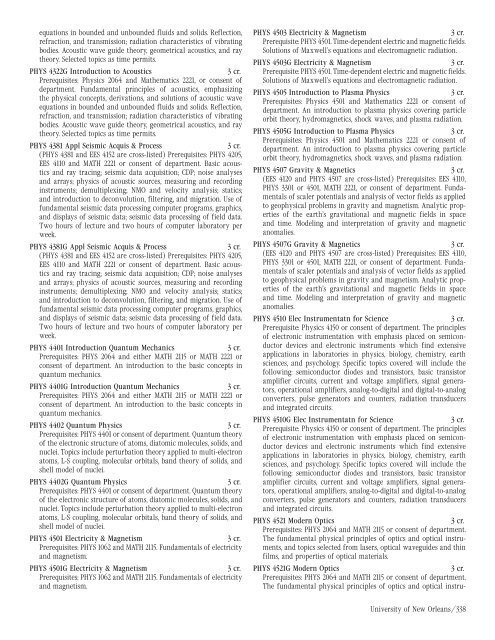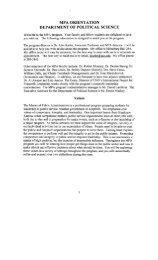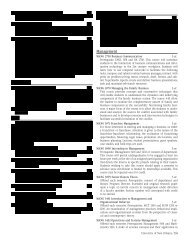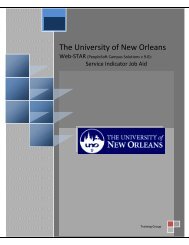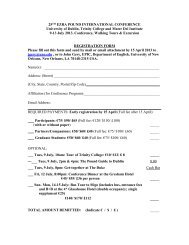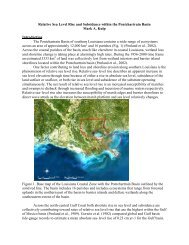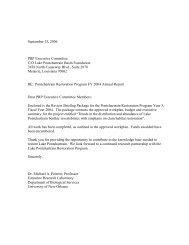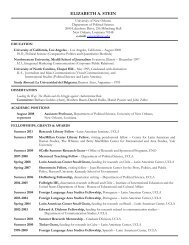Untitled - University of New Orleans
Untitled - University of New Orleans
Untitled - University of New Orleans
You also want an ePaper? Increase the reach of your titles
YUMPU automatically turns print PDFs into web optimized ePapers that Google loves.
equations in bounded and unbounded fluids and solids. Reflection,<br />
refraction, and transmission; radiation characteristics <strong>of</strong> vibrating<br />
bodies. Acoustic wave guide theory, geometrical acoustics, and ray<br />
theory. Selected topics as time permits.<br />
PHYS 4322G Introduction to Acoustics<br />
3 cr.<br />
Prerequisites: Physics 2064 and Mathematics 2221, or consent <strong>of</strong><br />
department. Fundamental principles <strong>of</strong> acoustics, emphasizing<br />
the physical concepts, derivations, and solutions <strong>of</strong> acoustic wave<br />
equations in bounded and unbounded fluids and solids. Reflection,<br />
refraction, and transmission; radiation characteristics <strong>of</strong> vibrating<br />
bodies. Acoustic wave guide theory, geometrical acoustics, and ray<br />
theory. Selected topics as time permits.<br />
PHYS 4381 Appl Seismic Acquis & Process<br />
3 cr.<br />
(PHYS 4381 and EES 4152 are cross-listed) Prerequisites: PHYS 4205,<br />
EES 4110 and MATH 2221 or consent <strong>of</strong> department. Basic acoustics<br />
and ray tracing; seismic data acquisition; CDP; noise analyses<br />
and arrays; physics <strong>of</strong> acoustic sources, measuring and recording<br />
instruments; demultiplexing; NMO and velocity analysis; statics;<br />
and introduction to deconvolution, filtering, and migration. Use <strong>of</strong><br />
fundamental seismic data processing computer programs, graphics,<br />
and displays <strong>of</strong> seismic data; seismic data processing <strong>of</strong> field data.<br />
Two hours <strong>of</strong> lecture and two hours <strong>of</strong> computer laboratory per<br />
week.<br />
PHYS 4381G Appl Seismic Acquis & Process<br />
3 cr.<br />
(PHYS 4381 and EES 4152 are cross-listed) Prerequisites: PHYS 4205,<br />
EES 4110 and MATH 2221 or consent <strong>of</strong> department. Basic acoustics<br />
and ray tracing; seismic data acquisition; CDP; noise analyses<br />
and arrays; physics <strong>of</strong> acoustic sources, measuring and recording<br />
instruments; demultiplexing; NMO and velocity analysis; statics;<br />
and introduction to deconvolution, filtering, and migration. Use <strong>of</strong><br />
fundamental seismic data processing computer programs, graphics,<br />
and displays <strong>of</strong> seismic data; seismic data processing <strong>of</strong> field data.<br />
Two hours <strong>of</strong> lecture and two hours <strong>of</strong> computer laboratory per<br />
week.<br />
PHYS 4401 Introduction Quantum Mechanics<br />
3 cr.<br />
Prerequisites: PHYS 2064 and either MATH 2115 or MATH 2221 or<br />
consent <strong>of</strong> department. An introduction to the basic concepts in<br />
quantum mechanics.<br />
PHYS 4401G Introduction Quantum Mechanics<br />
3 cr.<br />
Prerequisites: PHYS 2064 and either MATH 2115 or MATH 2221 or<br />
consent <strong>of</strong> department. An introduction to the basic concepts in<br />
quantum mechanics.<br />
PHYS 4402 Quantum Physics<br />
3 cr.<br />
Prerequisites: PHYS 4401 or consent <strong>of</strong> department. Quantum theory<br />
<strong>of</strong> the electronic structure <strong>of</strong> atoms, diatomic molecules, solids, and<br />
nuclei. Topics include perturbation theory applied to multi-electron<br />
atoms, L-S coupling, molecular orbitals, band theory <strong>of</strong> solids, and<br />
shell model <strong>of</strong> nuclei.<br />
PHYS 4402G Quantum Physics<br />
3 cr.<br />
Prerequisites: PHYS 4401 or consent <strong>of</strong> department. Quantum theory<br />
<strong>of</strong> the electronic structure <strong>of</strong> atoms, diatomic molecules, solids, and<br />
nuclei. Topics include perturbation theory applied to multi-electron<br />
atoms, L-S coupling, molecular orbitals, band theory <strong>of</strong> solids, and<br />
shell model <strong>of</strong> nuclei.<br />
PHYS 4501 Electricity & Magnetism<br />
3 cr.<br />
Prerequisites: PHYS 1062 and MATH 2115. Fundamentals <strong>of</strong> electricity<br />
and magnetism.<br />
PHYS 4501G Electricity & Magnetism<br />
3 cr.<br />
Prerequisites: PHYS 1062 and MATH 2115. Fundamentals <strong>of</strong> electricity<br />
and magnetism.<br />
PHYS 4503 Electricity & Magnetism<br />
3 cr.<br />
Prerequisite: PHYS 4501. Time-dependent electric and magnetic fields.<br />
Solutions <strong>of</strong> Maxwell’s equations and electromagnetic radiation.<br />
PHYS 4503G Electricity & Magnetism<br />
3 cr.<br />
Prerequisite: PHYS 4501. Time-dependent electric and magnetic fields.<br />
Solutions <strong>of</strong> Maxwell’s equations and electromagnetic radiation.<br />
PHYS 4505 Introduction to Plasma Physics<br />
3 cr.<br />
Prerequisites: Physics 4501 and Mathematics 2221 or consent <strong>of</strong><br />
department. An introduction to plasma physics covering particle<br />
orbit theory, hydromagnetics, shock waves, and plasma radiation.<br />
PHYS 4505G Introduction to Plasma Physics<br />
3 cr.<br />
Prerequisites: Physics 4501 and Mathematics 2221 or consent <strong>of</strong><br />
department. An introduction to plasma physics covering particle<br />
orbit theory, hydromagnetics, shock waves, and plasma radiation.<br />
PHYS 4507 Gravity & Magnetics<br />
3 cr.<br />
(EES 4120 and PHYS 4507 are cross-listed) Prerequisites: EES 4110,<br />
PHYS 3301 or 4501, MATH 2221, or consent <strong>of</strong> department. Fundamentals<br />
<strong>of</strong> scaler potentials and analysis <strong>of</strong> vector fields as applied<br />
to geophysical problems in gravity and magnetism. Analytic properties<br />
<strong>of</strong> the earth’s gravitational and magnetic fields in space<br />
and time. Modeling and interpretation <strong>of</strong> gravity and magnetic<br />
anomalies.<br />
PHYS 4507G Gravity & Magnetics<br />
3 cr.<br />
(EES 4120 and PHYS 4507 are cross-listed) Prerequisites: EES 4110,<br />
PHYS 3301 or 4501, MATH 2221, or consent <strong>of</strong> department. Fundamentals<br />
<strong>of</strong> scaler potentials and analysis <strong>of</strong> vector fields as applied<br />
to geophysical problems in gravity and magnetism. Analytic properties<br />
<strong>of</strong> the earth’s gravitational and magnetic fields in space<br />
and time. Modeling and interpretation <strong>of</strong> gravity and magnetic<br />
anomalies.<br />
PHYS 4510 Elec Instrumentatn for Science<br />
3 cr.<br />
Prerequisite: Physics 4150 or consent <strong>of</strong> department. The principles<br />
<strong>of</strong> electronic instrumentation with emphasis placed on semiconductor<br />
devices and electronic instruments which find extensive<br />
applications in laboratories in physics, biology, chemistry, earth<br />
sciences, and psychology. Specific topics covered will include the<br />
following: semiconductor diodes and transistors, basic transistor<br />
amplifier circuits, current and voltage amplifiers, signal generators,<br />
operational amplifiers, analog-to-digital and digital-to-analog<br />
converters, pulse generators and counters, radiation transducers<br />
and integrated circuits.<br />
PHYS 4510G Elec Instrumentatn for Science<br />
3 cr.<br />
Prerequisite: Physics 4150 or consent <strong>of</strong> department. The principles<br />
<strong>of</strong> electronic instrumentation with emphasis placed on semiconductor<br />
devices and electronic instruments which find extensive<br />
applications in laboratories in physics, biology, chemistry, earth<br />
sciences, and psychology. Specific topics covered will include the<br />
following: semiconductor diodes and transistors, basic transistor<br />
amplifier circuits, current and voltage amplifiers, signal generators,<br />
operational amplifiers, analog-to-digital and digital-to-analog<br />
converters, pulse generators and counters, radiation transducers<br />
and integrated circuits.<br />
PHYS 4521 Modern Optics<br />
3 cr.<br />
Prerequisites: PHYS 2064 and MATH 2115 or consent <strong>of</strong> department.<br />
The fundamental physical principles <strong>of</strong> optics and optical instruments,<br />
and topics selected from lasers, optical waveguides and thin<br />
films, and properties <strong>of</strong> optical materials.<br />
PHYS 4521G Modern Optics<br />
3 cr.<br />
Prerequisites: PHYS 2064 and MATH 2115 or consent <strong>of</strong> department.<br />
The fundamental physical principles <strong>of</strong> optics and optical instru-<br />
<strong>University</strong> <strong>of</strong> <strong>New</strong> <strong>Orleans</strong>/338


